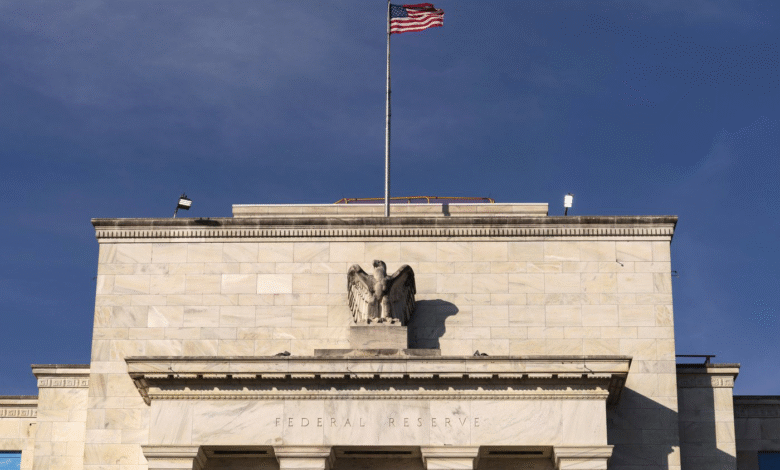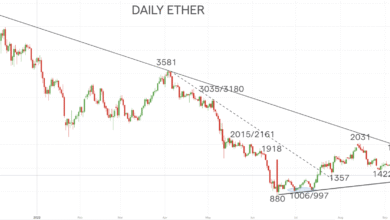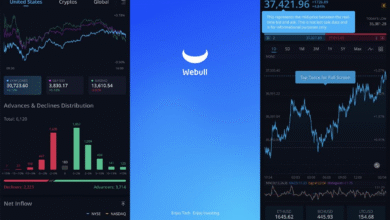Federal Reserve Rate Cut Dreams Fade Ahead of July Meeting

As discussions around the Federal Reserve rate cut heat up, many investors and economists are grappling with the implications for the U.S. economy. Despite a surge in both equities and cryptocurrency performance, the prospects of a July rate cut are dwindling, with current forecasts reflecting a staggering 93.3% chance that the Fed will refrain from altering interest rates during the upcoming FOMC meeting. This hesitation comes in the wake of previous cuts that were made under President Biden’s administration, which aimed to bolster economic growth and stabilize employment as inflation rates began to settle. However, frustration is mounting from various fronts, including from former President Trump, who is vocal about his discontent with the Fed’s path under Chair Jerome Powell. The CME FedWatch tool suggests that the odds of a quarter-point cut remain at a mere 6.7%, indicating that any shifts in monetary policy are likely to be minimal in the near term.
In the realm of monetary policy decision-making, the anticipation of potential interest rate adjustments often takes center stage. As we approach the Federal Open Market Committee (FOMC) convening on July 30, the dialogue around a potential reduction in the federal funds rate becomes increasingly critical. Market analysts and stakeholders are particularly attentive to indicators that may influence Fed decisions, especially in light of rising discontent from notable figures like Trump regarding the central bank’s strategies. While rate cuts have historically aimed to stimulate economic growth, current sentiment largely leans towards maintaining the status quo for the foreseeable future. Observations from tools like the CME FedWatch present a compelling narrative on market expectations, paving the way for focused discussions leading into the FOMC meeting.
Current Expectations for the Federal Reserve’s July Rate Cut
As we approach the Federal Open Market Committee (FOMC) meeting on July 30, 2025, the expectations surrounding a potential July rate cut have significantly diminished. The current odds, as estimated by the CME FedWatch tool, show a staggering 93.3% probability that the Federal Reserve will maintain its existing interest rates. This sentiment is reinforced by strong market performance, with equities and bitcoin reaching record highs. Investors are cautiously optimistic about market stability but remain skeptical about major shifts in monetary policy.
The last significant federal funds rate (FFR) reduction occurred in December 2024, which saw the rate adjusted to its present range of 4.25%–4.50%. The anticipation of a July rate cut appears to be a fading dream, overshadowed by the Fed’s recent pause in adjusting rates while other central banks have begun to ease. This situation continues to incite frustration among several quarters, including the Trump administration, which has publicly critiqued the Federal Reserve’s reluctance to stimulate the economy further.
The Fed’s continued pause does seem puzzling, especially since inflation signals suggest a cooling economy. The market participants, particularly traders using prediction markets like Polymarket, are placing their bets on steadiness rather than cuts, with about 95% expecting the rates will remain unchanged in July. As the FOMC meeting date nears, traders and investors alike will need to keep a close watch on any unforeseen developments that could sway these expectations.
Moreover, the ongoing dilemma of whether to cut rates could materialize into a significant financial narrative for September 2025. With the CME FedWatch tool reflecting a 63.9% probability of a quarter-point cut in September, the dynamics surrounding the July FOMC meeting will certainly influence those September bets. This adds another layer of complexity as traders anticipate how the Federal Reserve’s decisions might intersect with market behaviors positively.
The Political Influence on Rate Decisions: Trump’s Perspective
President Donald Trump’s frustration with the Federal Reserve and its leadership under Jerome Powell has been a recurring theme since he took office. Trump has consistently urged the Fed to lower interest rates to stimulate economic growth and support the stock market, which directly impacts his administration’s success metrics. However, the Fed has shown reluctance in meeting these demands, emphasizing their commitment to curbing inflation and ensuring economic stability over political influence.
This tension exemplifies the challenges faced by the Fed as it navigates external pressures while striving for independence in its monetary policy decisions. As seen in recent months, the conversations surrounding the July rate cut, the predictions derived from the CME FedWatch tool, and the general outlook from traders signify a broader sentiment disconnected from political narratives. Nonetheless, Trump’s mounting frustration suggests that any failures to align Fed actions with his expectations could have repercussions for the central bank’s future operations, especially in how their policies are perceived by the public.
The political landscape surrounding interest rates raises crucial questions: How transparent should the Fed be regarding its decision-making process? Should it be more responsive to the preferences of the executive branch, or should it continue to prioritize economic indicators? These debates will only intensify as the July FOMC meeting approaches, shaping the narrative around the Fed’s actions and fostering a climate of speculation among investors.
Furthermore, as Trump continues to express his sentiments about the current interest rates, it is essential for traders and investors to stay informed and reactive. The interplay between political pressure and monetary policy will undoubtedly shape market behaviors, influencing equities, crypto, and other financial instruments in this uncertain period.
Analyzing Market Reactions to Fed Rate Decisions
The response of financial markets to the Federal Reserve’s rate decisions is multifaceted and can often be volatile. As the CME FedWatch tool demonstrates a predominant expectation for the Fed to keep rates unchanged in July, market participants are positioned to react accordingly. A stable interest rate environment typically fosters confidence among investors, leading to increased flow in equities and other investable assets like bitcoin. However, should the Fed introduce any unexpected changes, markets could react sharply, indicating traders’ sensitivity to monetary policy shifts.
Traders on platforms like Polymarket exemplify this sentiment, with a substantial majority banking on consistent rates as the FOMC meeting approaches. With options reflecting a mere 6.7% chance of a cut, the psychological aspect of perceived security contributes to continued market growth. For instance, equities reaching record highs signal not only investor confidence but also the market’s collective response to the broader economic landscape. Conversely, signs of an impending cut could introduce uncertainty, leading to market fluctuations over the subsequent trading days.
Moreover, the intersection of global economic trends with the U.S. monetary policy plays a crucial role in shaping investor sentiments. As other central banks begin to ease rates, the Fed’s decision to remain firm could attract foreign investment, thereby influencing the strength of the dollar and trade dynamics. This interconnectedness underscores the importance of the Fed’s strategies not just in the national context but also on a global scale.
In summary, the anticipation surrounding the Fed’s rate decisions acts as a bellwether for market behavior. The potential July rate cut remains a focal point as traders prepare for the outcomes of the FOMC meeting. Understanding these reactions requires a multi-dimensional perspective that considers political implications, economic stability, and investor psychology.
Implications of Interest Rates on Economic Growth
Interest rates are pivotal in shaping the economic landscape, affecting everything from consumer spending to corporate investments. By holding steady on rates, the Federal Reserve aims to ensure that credit remains affordable, thereby fostering economic expansion. The July rate cut speculation highlights a calendar of critical assessments regarding how monetary policy influences growth, particularly as inflation rates fluctuate.
Lower interest rates typically reduce borrowing costs for consumers and businesses, which can stimulate spending and investment. Conversely, maintaining higher rates can control inflation but may also dampen economic activity. The Fed’s cautious stance, highlighted by the CME FedWatch tool’s projections, underscores the delicate balance policymakers must maintain to encourage economic momentum while preventing overheating of the economy.
Furthermore, examining the relationship between interest rates and investor behavior provides insights into market trends. If the Fed chooses not to cut rates in July, the prevailing market sentiment, evident in the projections of traders across platforms like Polymarket, suggests that investors will remain focused on stability and long-term growth. By stabilizing rates, the Fed fosters confidence — key for sustaining GDP growth and maintaining effective employment rates.
The overarching goal of any Fed policy is to support maximum employment and stable prices. As such, understanding the implications of interest rates on economic growth is vital for market participants. Any decisions taken in July will not only shape immediate market outcomes but also influence economic perceptions down the line.
Looking Ahead: What to Expect from Future FOMC Meetings
As we look beyond July, the upcoming Federal Open Market Committee (FOMC) meetings signal pivotal moments for the economy. The Fed remains in a tight spot, as market indicators reflect divergent views on future interest rate adjustments. While 93.3% of traders currently predict no movement this month, the anticipation surrounding September’s meeting reveals a shift in expectations with 63.9% forecasting a potential quarter-point cut. These evolving dynamics could result in substantial market reassessments in the coming months.
Should the Federal Reserve decide to cut rates, it is anticipated to have an immediate impact on various asset classes, including equities and cryptocurrencies. A lower federal funds rate might spur greater risk-taking behavior among investors, ultimately driving up asset prices and creating a bullish sentiment in susceptible markets. Therefore, traders and investors are likely to position themselves strategically in preparation for these outcomes, taking cues from macroeconomic trends and geopolitical developments.
Moreover, market predictions highlight the subsequent effects any rate decision could impose, particularly in light of the cautious optimism following economic recovery. Should inflation pressures wane or other central banks continue to ease, the Fed’s potential shift towards a more accommodative policy stance becomes more tantalizing over the coming months.
In conclusion, the Federal Reserve’s strategy at FOMC meetings is crucial not just for rate decisions themselves but for crafting broader economic narratives that influence market behaviors. As economic indicators evolve, the expectation of Fed decisions will continue to shape the landscape for investors across sectors, keeping them engaged as they navigate an unpredictable financial environment.
The Role of Prediction Markets in Anticipating Fed Moves
Prediction markets, like Polymarket and Kalshi, have become instrumental in understanding market sentiment regarding potential Federal Reserve moves, particularly concerning interest rates. By aggregating the collective wisdom of traders, these platforms offer insights that often serve as real-time gauges for where expectations lie. As the July FOMC meeting nears, the sentiment reflected by these platforms provides key indicators of how market participants view the likelihood of rate cuts.
Recent figures from prediction markets suggest that while traders place considerable confidence in the Fed’s decision to maintain current rates, there remains a notable divergence for the upcoming September meeting. The 63.9% anticipating a potential cut showcases how traders are strategically adjusting their positions based on their interpretations of economic data and Fed communications. The ability of these markets to aggregate data effectively places them at the forefront of financial speculation, providing insights that are essential to traders and investors.
Furthermore, the liquidity in such markets allows for more nuanced bets that reflect the complexities of monetary policy expectations, giving traders a voice in how they prioritize the economic indicators driving their decisions. The interplay between political narratives and market sentiment is continuously influenced by ever-evolving predictions, which can shift dramatically as new economic information comes to light.
In summary, prediction markets serve as crucial tools for anticipating Federal Reserve moves. Understanding their influence allows investors to navigate potential outcomes and prepare effectively for fluctuations in response to the Fed’s decisions.
Interest Rates and Their Impact on Asset Classes
One of the most significant implications of interest rate decisions by the Federal Reserve is their direct impact on various asset classes. When interest rates are low, borrowing becomes cheaper, which encourages consumer spending and business investments. This can lead to rising stock prices and increased participation in riskier assets, such as cryptocurrencies. Following July’s projected rate stance, many investors expect to see these trends reflected in market performance, especially as uncertainty looms.
Alternatively, higher interest rates typically lead to a tightening of financial conditions, resulting in reduced liquidity in the markets. This scenario can create headwinds for equities and risk assets, as investors may flock to safer bonds that yield higher returns. The recent performance of bitcoin and equities in tandem suggests that the prospect of a rate cut could serve as a catalyst for further growth in these asset classes.
Moreover, understanding how different asset classes react to interest rate changes is crucial for strategic asset allocation. Each trading epoch might compel investors to reevaluate their portfolios in anticipation of Fed decisions, leading to diversification strategies or shifts towards traditionally supportive assets during fluctuating rate environments.
In conclusion, the interplay between interest rates and asset classes dictates investor strategies and overall market sentiment. As anticipation builds around September’s FOMC meeting, traders and investors must remain vigilant to harness the opportunities presented by these monetary policy decisions.
The Future of Monetary Policy Amidst Economic Uncertainty
As the Federal Reserve grapples with economic uncertainty, the future of monetary policy remains a subject of extensive debate. The mixed signals from economic indicators, coupled with global responses to inflation, create a complex backdrop for the Fed as it contemplates its next moves. Given the recent trends in the CME FedWatch tool, there is an intensified focus on how rate adjustments could usher in new economic phases and possibly mitigate risks surrounding potential recessionary environments.
Moreover, as inflationary pressures continue to fluctuate, the Federal Reserve’s approach to monetary policy will bear significant implications for economic growth, consumer behavior, and market dynamics. Investors must acclimate to the potential for prolonged periods of uncertainty, requiring them to remain adaptable and attentive to shifts in the Fed’s narrative as they navigate their investment decisions.
Ultimately, the Fed’s ability to maintain its independence while responding effectively to economic developments will be crucial in shaping the future monetary landscape. Market participants should closely monitor upcoming FOMC meetings and economic reports as these will guide the Federal Reserve’s strategy, forming the basis for how financial conditions evolve in the months to come.
In summary, the ongoing evolution of interest rates against the backdrop of economic uncertainty is likely to keep traders on alert, shaping behaviors and strategies that mirror the Fed’s trajectory as it evolves.
Frequently Asked Questions
What are the expectations for the Federal Reserve rate cut in July 2025?
As of now, expectations for a Federal Reserve rate cut in July 2025 are low, with the CME FedWatch tool indicating only a 6.7% chance for a quarter-point cut. A substantial 93.3% of market participants anticipate no change during the upcoming FOMC meeting.
How does the CME FedWatch tool influence predictions for a Federal Reserve rate cut?
The CME FedWatch tool provides insights into market expectations regarding Federal Reserve rate cuts. Currently, it shows that only a 6.7% chance exists for a July rate cut, while a larger percentage expects rates to remain unchanged.
What is the significance of the FOMC meeting on July 30, 2025, regarding the Federal Reserve rate cut?
The FOMC meeting on July 30, 2025, is crucial as it will determine if the Federal Reserve will adjust interest rates. Current predictions suggest that the Fed is likely to hold rates steady, aligning with the 93.3% chance of no rate cut reflected in the market.
How has Trump’s frustration with the Federal Reserve impacted expectations for a rate cut?
President Trump’s frustration with the Federal Reserve and Chair Jerome Powell has heightened scrutiny and debate over potential rate cuts. Although he advocates for lower rates to stimulate the economy, the prevailing market sentiment suggests that the Fed will maintain current rates.
What are the implications of a Federal Reserve rate cut for markets like equities and bitcoin?
A Federal Reserve rate cut typically leads to increased liquidity, which can boost equities and risk assets like bitcoin. Current market conditions, however, indicate a traditional approach with no expected cut, which may affect future market behavior as traders adjust their strategies.
Why do some traders expect a greater chance of a Federal Reserve rate cut in September?
Traders expect a higher likelihood of a Federal Reserve rate cut in September due to changing economic conditions and market sentiment, with the CME FedWatch tool showing a nearly 63.9% chance for a quarter-point cut at that time.
What factors are influencing the Federal Reserve’s decision on interest rates in 2025?
Factors influencing the Federal Reserve’s decision on interest rates include inflation trends, economic growth indicators, and market reactions. Current data reflects confidence that inflation is stabilizing, reducing the urgency for immediate rate cuts.
How do market predictions for the Federal Reserve rate cut affect consumer behavior?
Market predictions regarding a Federal Reserve rate cut can influence consumer behavior as expectations for lower borrowing costs motivate spending and investment decisions. Presently, the anticipation of no rate cut may lead consumers to be more cautious.
What can we expect from future Federal Reserve rate cut discussions?
Future discussions on Federal Reserve rate cuts will likely focus on economic indicators, inflation data, and global monetary policy trends. Analysts and traders will attentively watch these factors, especially leading up to the September FOMC meeting.
| Key Points |
|---|
| Current Expectations |
| As of 20 days before the July FOMC meeting, the likelihood of a rate cut remains low at 6.7%. |
| Historical Context |
| The last rate cut occurred on December 18, 2024, marking the end of cuts during the Biden administration while signaling confidence in cooling inflation. |
| Market Sentiment |
| 93.3% of market participants anticipate no rate change for July, with similar sentiments reflected on platforms like Polymarket and Kalshi. |
| Implications for Future Meetings |
| For the September meeting, 63.9% of CME futures participants predict a potential quarter-point rate cut. |
Summary
The prospects for a Federal Reserve rate cut in July 2025 appear increasingly unlikely, as market expectations strongly favor the Fed maintaining the current rate. With a dominant 93.3% of investors predicting no change, any decisions made by the Fed will have significant implications for economic stability and market trends, especially with scrutiny from the Trump administration. The upcoming FOMC meetings will be crucial in shaping the Federal Reserve’s approach towards rate adjustments in the months ahead.




